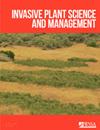在暴露于菊科最近的入侵者后,丛枝菌根真菌对本地植物和早期入侵者的稳定定殖
IF 1.2
4区 生物学
Q3 PLANT SCIENCES
引用次数: 3
摘要
摘要丛枝菌根真菌(AMF,Glomeromycota)是全球分布的植物根系共生体。与丛枝菌根的关系可以为在不利环境中建立任何植物提供至关重要的支持。我们假设新生植物的入侵与AMF对本地植物和早期入侵者(古生植物)的定殖变化有关。我们研究了在菊科四种新植物入侵的情况下,AMF在yarrow(Achillea millefolium L.)和野生胡萝卜(Daucus carota L.)(本地植物)、tansy(Tanacetum vulgare L.)和假燕麦(Arrhenatherum elatius(L.)P.Beauv.ex J.Presl&C.Presl)(古生植物)中定殖的变化,纽约紫苑[Sympyotrichum novi belgii(L.)G.L.Nesom agg.]、一年生飞蓬[Eirigeron annuus(L.)Pers.]和加拿大一枝黄花(Solidago canadensis L.)。尽管入侵地块与初级和次级矿物营养物质的可用性发生强烈变化有关,但植物优势度的变化并不能预测AMF在本地植物和古生植物中的定殖程度。本地和古生植物物种的AMF定殖对新生植物入侵没有反应,这表明AMF是菊科入侵中欧环境过程中的乘客,而不是驱动者。本文章由计算机程序翻译,如有差异,请以英文原文为准。
Stable colonization of native plants and early invaders by arbuscular mycorrhizal fungi after exposure to recent invaders from the Asteraceae family
Abstract Arbuscular mycorrhizal fungi (AMF, Glomeromycota) are globally distributed symbionts of plant roots. Relationships with arbuscular mycorrhizae can provide crucial support for the establishment of any plant in an unfavorable environment. We hypothesized that invasions of neophytes are associated with changes in the colonization of native plants and early invaders (archeophytes) by AMF. We examined changes in AMF colonization in yarrow (Achillea millefolium L.) and wild carrot (Daucus carota L.) (native plants) and tansy (Tanacetum vulgare L.) and false oatgrass [Arrhenatherum elatius (L.) P. Beauv. ex J. Presl & C. Presl] (archeophytes) in response to the invasion of four neophytes from the Asteraceae family, namely great globethistle (Echinops sphaerocephalus L.), New York aster [Symphyotrichum novi-belgii (L.) G. L. Nesom agg.], annual fleabane [Erigeron annuus (L.) Pers.], and Canada goldenrod (Solidago canadensis L.). We found that the AMF colonization of the Asteraceae neophytes was high in the studied monodominant invasions, and the AMF colonization of the neophytes was higher than or equal to that of the studied native plants and archeophytes. Changes in plant dominance did not serve as predictors of the extent of AMF colonization of the native plants and archeophytes despite the invaded plots being associated with strong changes in the availability of primary and secondary mineral nutrients. The absence of a response of AMF colonization of native and archeophyte plant species to the invasion of neophytes suggests that AMF are passengers, rather than drivers, in the course of Asteraceae invasions in central European environments.
求助全文
通过发布文献求助,成功后即可免费获取论文全文。
去求助
来源期刊

Invasive Plant Science and Management
PLANT SCIENCES-
CiteScore
2.20
自引率
9.10%
发文量
24
审稿时长
6-12 weeks
期刊介绍:
Invasive Plant Science and Management (IPSM) is an online peer-reviewed journal focusing on fundamental and applied research on invasive plant biology, ecology, management, and restoration of invaded non-crop areas, and on other aspects relevant to invasive species, including educational activities and policy issues. Topics include the biology and ecology of invasive plants in rangeland, prairie, pasture, wildland, forestry, riparian, wetland, aquatic, recreational, rights-of-ways, and other non-crop (parks, preserves, natural areas) settings; genetics of invasive plants; social, ecological, and economic impacts of invasive plants and their management; design, efficacy, and integration of control tools; land restoration and rehabilitation; effects of management on soil, air, water, and wildlife; education, extension, and outreach methods and resources; technology and product reports; mapping and remote sensing, inventory and monitoring; technology transfer tools; case study reports; and regulatory issues.
 求助内容:
求助内容: 应助结果提醒方式:
应助结果提醒方式:


